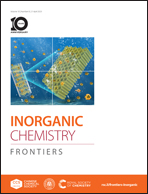Structural, magnetic and phase transition properties in S = ½ radical solid solutions of [FxCl1−x-BzPy][Ni(mnt)2] (x = 0.07–0.87)†
Abstract
Solid solutions offer an opportunity for modulating the structural and physical properties of materials and better understanding the origin of physical phenomena as well. Herein, two salts [R-BzPy][Ni(mnt)2] (R-BzPy+ = 4-R-benzylpyridinium, substituent group R = F, Cl; mnt2− = maleonitriledithiolate) and their solid solutions [FxCl1−x-BzPy][Ni(mnt)2] (x = 0.07–0.87) were prepared and characterized by IR, Raman and 1H NMR spectroscopy, microanalysis, PXRD, SXRD and TG techniques. All salts are isomorphic at room temperature with almost the same packing manner, where both cations and anions form segregated and regular columnar stacks. A magnetic phase transition occurs in each salt at a certain temperature (TC) in the range of 93–108 K, showing one-dimensional (1D) S = ½ regular spin chain behavior in the high temperature phase (HTP) and spin-gap characteristics (with singlet–triplet gap >500 K) in the low temperature phase (LTP). Remarkably, the solid solutions (x = 0.07–0.39) display regular antiferromagnetism (AFM), while others show uniform ferromagnetic (FM) chain behavior in the HTP. It is discussed that the solid solutions (x = 0.07–0.54) show higher TC than the two parent salts, and the magnetic coupling feature in the HTP anomalously changes with fluorine content (x) in [FxCl1−x-BzPy][Ni(mnt)2] (x = 0–1).
![Graphical abstract: Structural, magnetic and phase transition properties in S = ½ radical solid solutions of [FxCl1−x-BzPy][Ni(mnt)2] (x = 0.07–0.87)](/en/Image/Get?imageInfo.ImageType=GA&imageInfo.ImageIdentifier.ManuscriptID=D3QI00114H&imageInfo.ImageIdentifier.Year=2023)


 Please wait while we load your content...
Please wait while we load your content...